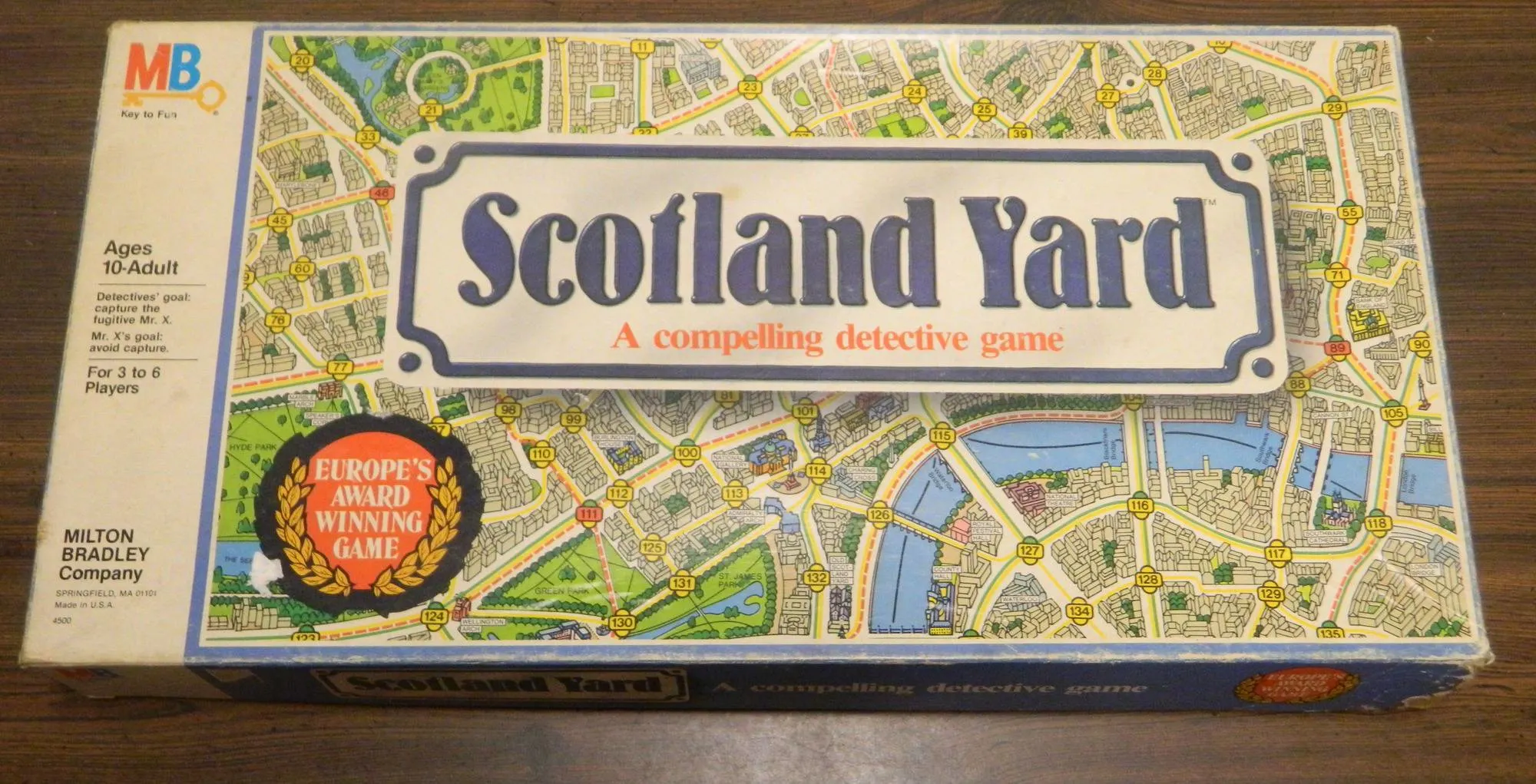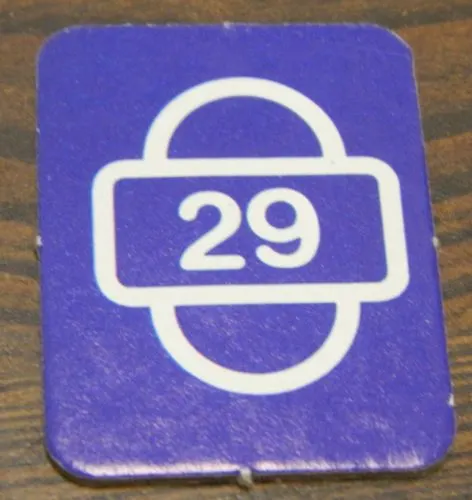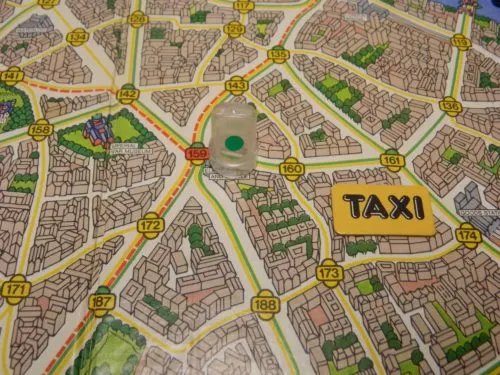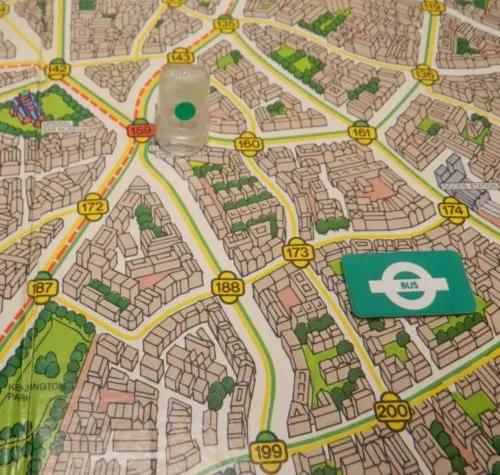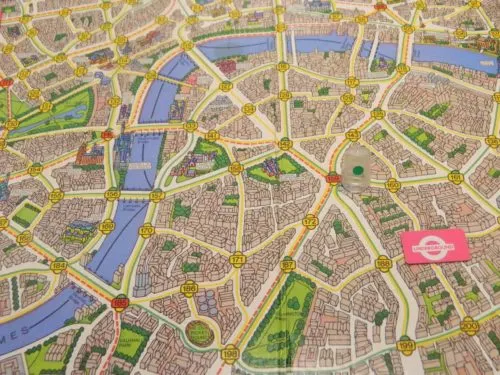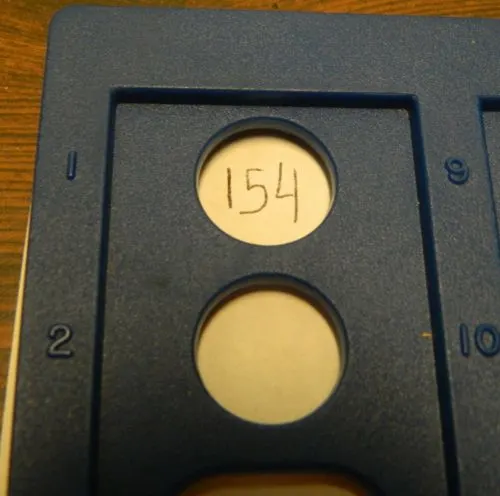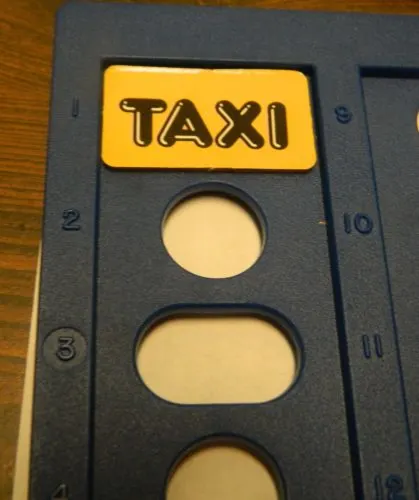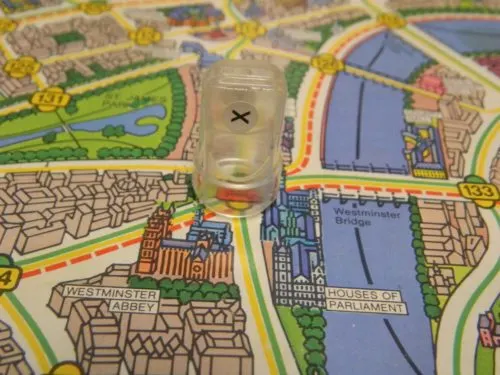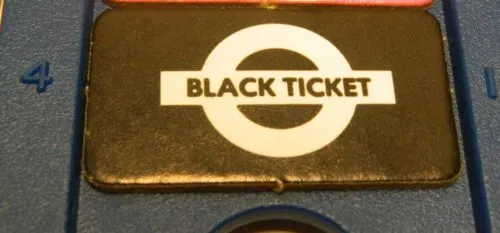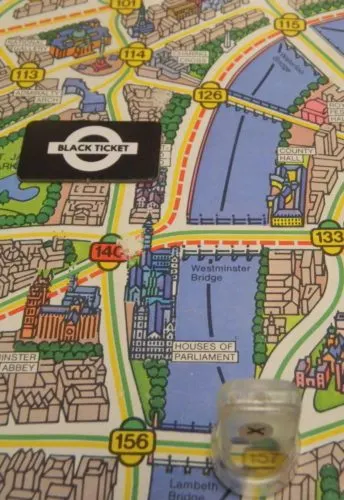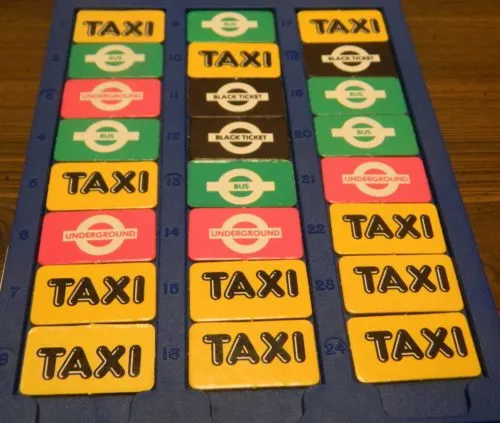Winner of the 1983 Spiel Des Jahres (Game of the Year), Scotland Yard has quite the pedigree in the board game industry. Scotland Yard is one of the first games to use the mechanic of all but one of the players cooperating to try and catch the other player. After Scotland Yard was released, this mechanic ended up being used in quite a few well regarded board games which include Clue The Great Museum Caper, The Fury of Dracula, and Letters from Whitechapel. A while back I took a look at Cue The Great Museum Caper and in that review I mentioned that I wanted to compare it to Scotland Yard as the two games have quite a bit in common. Scotland Yard is not a perfect game but it deserves a lot of credit for its’ originality in creating a fun unique experience that many games later tried to implement.
How to Play Scotland Yard
Setup
- Players choose which player will play as Mr. X.
- The player playing as Mr. X takes the uncolored pawn and the detective pad and cover.
- The rest of the players will play as the detectives. The players decide on how they want to divvy up the five detective pawns with each player taking at least one pawn.
- Each detective pawn is given fare tickets. If a player is controlling more than one detective pawn, the tickets should be kept separate so they are only used for the pawn they were originally given to. The colored bureau tokens are used to indicate which pawns the tickets belong to. Each detective pawn will receive the following tokens:
- 10 taxi
- 8 bus
- 4 underground
- The player playing as Mr. X will receive the following fare tickets:
- 4 taxi
- 3 bus
- 3 underground
- 5 black fare tickets
- 2 double move tickets
- Each player/detective pawn chooses a start card. Each detective pawn is placed on the corresponding spot on the gameboard. Mr. X’s will start on the space corresponding to the card they draw but they keep their location hidden from the other players.
- The player playing as Mr. X will start the game.
Movement
On a player’s turn they will play one of their tickets in order to use a form of transportation. In order to use a form of transportation it has to be available in their current location which is indicated by the colors on their current location’s number. The detective players and Mr. X can use three different forms of movement.
- Taxi: When using a taxi the player can follow one of the yellow lines from their current location to a neighboring location.
- Bus: The bus allows a player to move to another location that is connected to their current location by a green line.
- Underground: When using the underground the player can move to a neighboring location connected to their current location by a red dotted line.
When moving a couple rules must be followed:
- You may only move to the next stop of your chosen form of transportation. You can not skip through a stop and move to the next location on a route.
- You cannot choose to stay on your current location instead of moving. You must move on each turn.
- A detective pawn cannot stop on a space occupied by another detective pawn. If Mr. X moves to a space occupied by a detective pawn, they immediately lose the game.
After a player has moved, play passes to the next player clockwise.
Mr. X’s Turn
On Mr. X’s turn the player controlling him will look at the board and determine where they will move him. The goal of the Mr. X player is to avoid the detective pawns. Unlike the detectives who indicate their current location by moving their pawns on the gameboard, the Mr. X player will write down the number for their new location.
They will then cover the number with the ticket for the form of transportation they used. This is done to show the detectives what type of transportation Mr. X used.
Occasionally Mr. X will have to reveal his location to the detectives (known as surfacing). After Mr. X’s 3rd, 8th, 13th, 18th and 24th move the player playing as Mr. X has to place their pawn on the gameboard to indicate their current location. On their next turn the Mr. X player can remove the pawn from the gameboard as they are now on a different space.
To help Mr. X escape from the detectives, he has access to a couple special moves.
The Mr. X player will receive two double move tokens. When a double move token is played the player is able to play two transportation tickets and thus move two times before the rest of the players can move. The player can either use the same mode of transportation twice or they could use different forms of transportation. The player records these two moves the same as they record a normal move. If a player has to surface after one of their moves, they need to make sure that they reveal their location after the correct movement. After making both moves the player discards the double move token that they used.
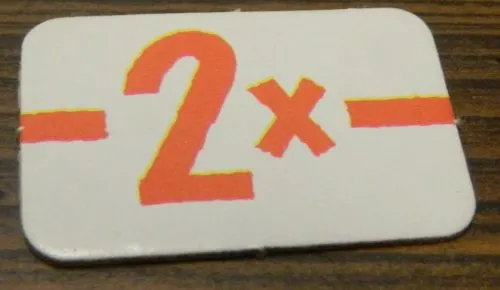
This player has played one of their 2x pieces so they will get to move twice before the detectives get to move again.
Mr. X is also given five black tickets at the beginning of the game. These tickets can act as any type of transportation ticket but they hide from the detectives what form of transportation was used.
Black tickets can also be used to move between two of the cities connected with a black line on the river.
Detective’s Turn
On a detective’s turn they can consult with the other detectives to devise a strategy for catching Mr. X. The player chooses where they want to move their pawn next. They pay the corresponding ticket card to the Mr. X player and move their pawn to its new location.
If a detective should ever get stuck in a location and not have a ticket that they can use to leave the location, that detective no longer moves in the game. The pawn will stay on their current location for the rest of the game.
End of Game
The game can end in one of two ways.
If one of the detectives move to the space that Mr. X currently occupies or Mr. X moves to a space occupied by a detective, the game immediately ends. The Mr. X player places their pawn on the gameboard to reveal their location. All of the detectives win the game and the Mr. X player loses.
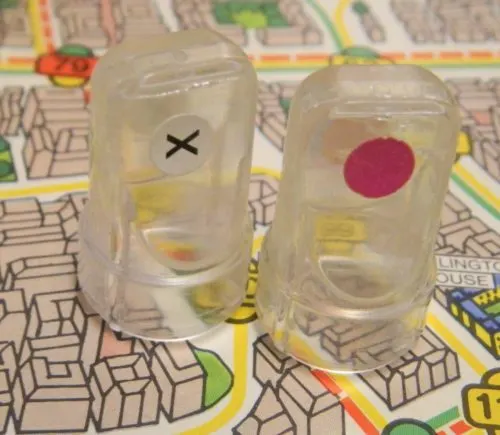
The purple player landed on the space that Mr. X was on. Mr. X was captured so the players have won the game.
If all of the detectives have run out of tickets (after 24 rounds have been played) or don’t have any tickets that they can use to leave their current location, Mr. X wins as none of the detectives can move to their location.
My Thoughts on Scotland Yard
I would say most people have probably never played a game before like Scotland Yard. Scotland Yard was really unique for its time as it basically helped create the genre where all but one of the players have to work together in order to catch the other player. This proved to be a popular mechanic as it has been used by several other really popular board games through the years. If you have never played one of these type of games before, it is kind of hard to fully explain what it feels like playing the game.
Basically Scotland Yard feels like a giant game of Cat and Mouse. One player plays as the mouse (Mr. X) while the rest of the other players play as cats (detectives) trying to catch them. Players play tiles in order move from space to space. Mr. X is trying to escape capture while the other players are trying to surround him so he can’t escape. Mr. X usually gets to keep their moves hidden but will occasionally have to reveal their location. At this point the detectives need to analyze which forms of transportation Mr. X used in order to narrow down where he could have went. Eventually the detectives are likely going to start closing in on Mr. X, so Mr. X has to try to find a way to get past them in order to survive long enough to win the game.
While not perfect I think Scotland Yard is a good game and deserves a lot of credit for inspiring several other beloved games. I think the game works well for a couple reasons.
At first glance it might not look like there is much to the game. Players take turns playing tickets in order to move to different spots on the board. This is basically the only mechanic in the game. As this is all there is to the game, it is actually quite easy to pick up and play Scotland Yard. The game has a recommended age of 10+ but I think kids a little younger shouldn’t have too many troubles with the game. They might not fully get the strategy but they should have no troubles with the actual gameplay. This simplicity also makes Scotland Yard simple enough that you can play it with people that normally only play games like Monopoly.
It might be simple to play but Scotland Yard has a lot of strategy hidden under the surface. Luck does not play much of a role in the game. Outside of randomly drawing your starting space (more on this later) and just having the detectives do a good job of guessing Mr. X’s location, the game doesn’t rely on luck. The players who play the game the best are likely going to win the game. Mr. X has the advantage of having their moves hidden most of the time while the detectives have the advantage of numbers. Being able to figure out what the other side is planning can give you a big advantage in the game.
I think the best thing about Scotland Yard though is that it is such a unique experience. While there have been some other games that have replicated a lot of what Scotland Yard did (Fury of Dracula and Letter From Whitechapel in particular), Scotland Yard deserves credit for being the first game to come up with the idea. For this reason I think it was well deserving of the 1983 Spiel Des Jahres. If you have never tried one of these type of games before you really should as it is unlike any other board game that you have ever played.
Most board games have a pretty set time limit but Scotland Yard’s length can vary quite a bit. It all comes down to whether the detectives can catch Mr. X and how fast they can do it. Games could take 15 minutes if the detectives quickly catch Mr. X or they could take up to an hour. The length is also going to depend on how long the detectives debate their options. While it usually shouldn’t take too long to figure out what you want to do on a particular turn, the game is susceptible to analysis paralysis. Some people are going to want to analyze every option but to keep the game moving they need to be willing to accept a non-perfect decision. This will make the game move faster and thus be more enjoyable for all of the players.
As I mentioned earlier a while back I took a look at Clue The Great Museum Caper. While the two games are not exactly the same it is pretty obvious that The Great Museum Caper took some inspiration from Scotland Yard. Of the two games I would say that Scotland Yard is slightly better even though both are good games and each have their own positives and negatives.
I think the area where Scotland Yard is significantly better than Clue The Great Museum Caper is the fact that it gives the detectives a fair chance of winning the game. In Clue The Great Museum Caper whenever you are spotted you can just rush to one of the windows and escape. In Scotland Yard you have to keep playing and actually try to escape from the other players and go back into hiding. You can implement a house rule in The Great Museum Caper in order to force the player to steal a certain number of paintings before escaping. Unless you make this number really high though, it is unlikely that the detectives will be able to catch the thief. The battle between Mr. X and the detectives seems to be much more fair in Scotland Yard. I would actually say the detectives have a slight advantage in the game.
As a detective you also get a lot more information about the location of Mr. X than the thief. In the Great Museum Caper you only get information about the player’s location if a player or camera spots them or when the player steals a painting. If the thief is smart you will rarely have the opportunity to see them. When they steal a painting they likely will do it in a way where they are long gone before you can catch them. Meanwhile Scotland Yard forces Mr. X to reveal their location periodically throughout the game. The tickets that Mr. X uses can also help put together where they have gone since they last had to reveal their location.
The one area where I think Clue The Great Museum Caper is better than Scotland Yard is playing as the individual player. While it is fun playing as Mr. X, it is kind of limited what you can do on any given turn. Most of the time you are going to just move further away from the detectives which means most moves are pretty obvious. There will be occasional times where the game gets tense as you try to sneak past the detectives but otherwise I would say it is more fun playing as the detectives. In the Great Museum Caper it is more fun playing as the thief. This is mostly because the thief has a lot more actions and opportunities in the game. This gives you opportunities to trick the other players which keeps you more invested in the game.
One of the biggest problems with Scotland Yard is the fact that the Mr. X player spends most of the game waiting for the other players. It is usually quite a bit quicker for the Mr. X player to make their move. They can see where all of the other players are located and thus can figure out where they want to move pretty quickly. There is quite a bit more thinking when it comes to the detectives as they have to figure out where Mr. X could have moved and then figure out a strategy of how they are going to move all of the detectives. As the Mr. X player starts each round, they have to wait for the other five detectives to move before they can play again. The Mr. X player could theoretically make their move, walk away for a couple minutes and then come back. If they did this it likely wouldn’t really impact their strategy that much. While this hurts the game I don’t really think there was anything the game could have done to fix it. It is just one of those problems that you have to deal with in these type of games.
Another potential problem with Scotland Yard is that Mr. X or the detectives could be put into a bad position solely due to the starting locations. I don’t mind the fact that players randomly draw a start tile which chooses where they start the game. This usually does a good job spreading out the detectives and Mr. X so they aren’t all in the same section of the board to begin the game. It does add some luck to the game though. In one game we played, Mr. X began the game in a section that had two detectives. This made it quite easy for the detectives to surround Mr. X which lead to him being captured pretty quickly. This is not going to be a problem most of the time but there are going to be some games where Mr. X is going to be at a disadvantage from the start of the game.
As there have been quite a few different versions of Scotland Yard made over the years, the component quality is going to somewhat depend on the version. The copy I played was the 1985 version of the game. The components for the 1985 version of the game are pretty average for the era. Most of the components consist of the cardboard tickets which are of a decent thickness but are kind of dull. The pawns are pretty generic. The logbook cover is very bland but I appreciate that the game made it easy to determine whether the current round is a round where Mr. X has to reveal his location. Overall I liked the gameboard as it shows quite a bit of detail that technically didn’t have to be included. There are a few sections of the map though where it is kind of hard to see the paths that you can take.
Should You Buy Scotland Yard?
Scotland Yard may not be as good as some more modern games but it deserved the Spiel Des Jahres that it won as it deserves a lot of credit creating its own mini genre. Basically Scotland Yard is responsible for the genre where all of the players have to work together in order to capture the other player. For those of you who have never played one of these type of games before, it is a unique experience. Scotland Yard succeeds because it is accessible and yet has quite a bit of strategy as luck has very little impact on the game. Whichever side makes the best moves will likely win the game. I think the detectives have a slight advantage but Mr. X can easily win the game if they make the right move at the right time to escape the detectives that are closing in. Having played Clue The Great Museum Caper before I would say that Scotland Yard is slightly better. I had fun with Scotland Yard and only really had two significant issues with the game. First Mr. X can get unlucky from the start if several detectives start in the same area as them. The bigger problem is that Mr. X doesn’t have a lot to do in the game and thus has to spend a lot of time waiting around for the detective players.
If you already own one of the board games that took inspiration from Scotland Yard, like Fury of Dracula or Letters From Whitechapel, it might not pay to pick up Scotland Yard as these games basically took Scotland Yard and improved it. If the concept of all of players working together to catch the other player doesn’t appeal to you, Scotland Yard might also not be for you. For people that don’t already have a similar game that also like the game’s concept, I would highly recommend picking up Scotland Yard.
If you would like to purchase Scotland Yard you can find it online: Amazon, eBay

